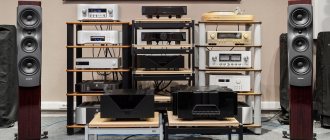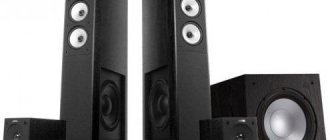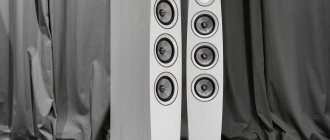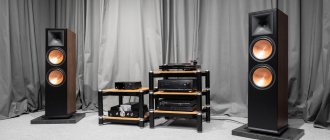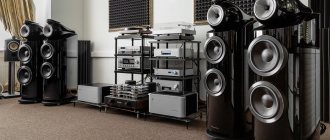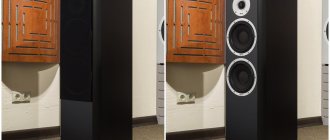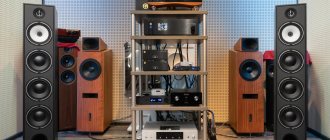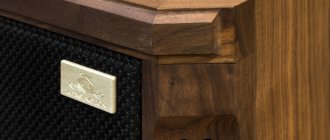The DALI Opticon series replaces the successful Ikon, which served two terms in the mid-price segment and won many awards. The line includes seven models from which you can assemble a set for multi-channel audio. But in this test we will talk about stereo. Opticon 6 are nice and fairly compact floorstanding units that will fit into most standard spaces. The company has repeatedly proven its ability to create excellent, and most importantly, music products with affordable prices. What happened this time?
The name of the model is consonant with the words “optics” and “optimization”. The second comes to mind when looking at the combination of a glossy varnished front panel and veneered remaining walls of the case. Somewhat reminiscent of the approach of some automakers, whose quality of plastic in the cabin varies depending on whether you can reach and touch it. And those details that are hidden from view are made of the cheapest material. Interestingly, if you look at the Opticon 6 in profile under certain lighting, an optical illusion arises: it seems as if the front panels are separated from the body. In short, the solution is interesting, but ambiguous.
With protective grilles on, the speakers hardly attract attention
The remaining elements of the exterior seem familiar - these are hybrid tweeters and paper cones of branded speakers reinforced with wood fibers. The patented SMC (Soft Magnetic Compound) material with low hysteresis and low eddy currents migrated to their magnetic system from the more expensive Rubicon series. Thanks to it, the linearity of the woofers has increased, and thanks to less heating, the stability of their operation.
Nonlinear arithmetic
In the speaker specifications given by the manufacturer, the number of bands is indicated as 2.5+0.5. How much is it really? In simple and understandable language, you can approach it formally and say that there are four of them, since each of the four available speakers is assigned different frequency ranges. They just partially overlap - one low-frequency driver works up to 800 Hz, and the other works before joining the high-frequency section, which gets down to business at 2200 Hz. It can be said to be traditional for DALI, representing an already well-known block of dome and ribbon tweeters, the first of which serves almost the entire audible range of high frequencies, from the mentioned 2200 Hz to 20 kHz, and the second begins to help it from 14 kHz.
Opticon 6 bass reflex adjustable to 42 Hz
It is recommended to install acoustics from a Danish company containing such hybrid tweeters parallel to each other, without facing the listener. In my case, the optimal picture was achieved in an intermediate position - with partial rotation. Otherwise (using the recommended position), the center of the stereo stage became somewhat unstable.
Of course, a lot depends on the room, but in general we can assume that Opticon 6 is very unpretentious in terms of placement. It is enough to maintain the distance between the speakers and the listener and select their direction. To be fair, I note that I have seen DALI models that are even less demanding for installation.
I listened to DALI Opticon 6 with an amplifier that fits the price category, Denon PMA-1600NE. The sources were a Moon 650D player and a Sony PCM-D100 recorder. The speakers were connected using Atlas Equator MkII speaker cables. A little later, a noticeably more expensive Denon PMA-2500NE amplifier took part in testing. Why and with what result will become clear a little later.
Bet on high frequencies
We can start where we left off - “Valkiria”. In the intro, the percussion is perfectly described, and the “opticons” really show it off with pleasure. Saturation, purity and “crystal”. When it comes to percussion, which was mixed by a sound engineer who has no idea about the existence of Hi-Fi, oddly enough, their sounding with “opticons” does not cause any particular rejection.
Although, it would seem, the tweeters were supposed to crush the listener, spraying in his direction with all their power and potential some of the most unpleasant sounds of inanimate nature. Apparently, a pair of tweeters also do not have particularly noticeable frequency response peaks, which, in particular, allows the listener to easily investigate where and in what place this or that drum kit cymbal is hidden, cleverly hidden by an inept sound engineer.
Vocals that fall within the range of the hybrid tweeter receive extremely airy tones and lightness of after-sounds, which generally refreshes the sound canvas.
According to general impressions, high frequencies are still emphasized - that is, there is a certain amount of dominance. And if we compare HF with the mid-frequency range, then the predominance of HF tends to zero, but is not equal to it. But the dominance of high frequencies over bass is beyond doubt. But the limits of decency are respected - and it does not feel like a “skewed foundation”. So, light flirting.
Seats on stage
With the recommended parallel installation, Opticon 6 provide a very wide panorama, perhaps even too wide. The vocals on Michel Colombier's "Morning Is Come Again" were centered, but a bit blurry. When turning directly towards the listener, the situation changed little; The most pleasant sound and almost natural placement of performers was achieved by partially rotating the speakers towards the listening point.
The fundamental resonance frequencies of both tweeters are outside their operating ranges
In passing, I note that thanks to the uniform radiation pattern of these speakers, especially at the top, the frequency balance remains almost the same when the installation angle changes. Therefore, during installation, the main manipulations serve to form the desired stereo scene, and extraneous factors do not interfere with this.
There are no problems with both the transmission of the frequency range and the dynamics of DALI. At the loudest and sharpest signal peaks, you get the feeling that there is still some headroom left. I immediately wanted to try them with high-resolution recordings. On Dead Can Dance's Toward The Within in DSD, the speakers sounded full and enveloping, weaving a sparkling web of metal strings around the listener.
Winning serve
Opticon shows loyalty to less perfect phonograms. On Lois Marshall's album, from the archives of the Moscow Conservatory, the room in which the performance took place seemed larger than it actually was; the frequency range was perceived wider than technology allowed in 1962; Overall the recording gave the impression of being more modern.
DALI continues to rely on its own speakers
However, this is the most striking example of the decoration that is inherent in these speakers. Almost any material that passes through them seems a little better than it really is. But they do it quite subtly, without slipping into kitsch or grotesque.
To reduce losses, the crossover is located immediately behind the input terminals
The speakers' penchant for exaggeration adds a new dimension to the performance experience: imagery. DALI easily transported me into the imaginary world of “Stalker”, all I had to do was put on a disc with Eduard Artemyev’s soundtracks. This cinematic sound prompted me to watch the Art Of Noise “Dragnet” video after the test. And it turned out that while listening to the track on the system under test, my imagination imagined more daring plot twists than those of the creators of the video.
Should I try the Opticon 6 with a higher-end amplifier? Yes, definitely. When I connected them to the Denon PMA-2500NE, many of the inaccuracies disappeared and the tendency to exaggerate was noticeably reduced. Phonograms in DSD format played analog smoothly, and my test recording of drums from a tiny hall named after. Myaskovsky of the Moscow Conservatory began to sound closer to the original, without exaggerating the volume of the room. The positioning accuracy of instruments has improved, but the greatest increase in quality was not achieved by acoustic music, but by rock and pop. These genres have become particularly enjoyable due to increased control of bass, rhythm and microdynamics. Despite the decrease in imagery, the already mentioned “Dragnet” was also interesting to listen to due to the prominence and tangibility of all elements of the arrangement.
DALI Opticon 6 acoustics test
The DALI Opticon series replaces the successful Ikon, which served two terms in the mid-price segment and won many awards. The line includes seven models from which you can assemble a set for multi-channel audio. But in this test we will talk about stereo.
Opticon 6 are nice and fairly compact floorstanding units that will fit into most standard spaces. The company has repeatedly proven its ability to create excellent, and most importantly, music products with affordable prices. What happened this time?
The name of the model is consonant with the words “optics” and “optimization”. The second comes to mind when looking at the combination of a glossy varnished front panel and veneered remaining walls of the case. Somewhat reminiscent of the approach of some automakers, whose quality of plastic in the cabin varies depending on whether you can reach and touch it. And those details that are hidden from view are made of the cheapest material. Interestingly, if you look at the Opticon 6 in profile under certain lighting, an optical illusion arises: it seems as if the front panels are separated from the body. In short, the solution is interesting, but ambiguous.
The remaining elements of the exterior seem familiar - these are hybrid tweeters and paper cones of branded speakers reinforced with wood fibers. The patented SMC (Soft Magnetic Compound) material with low hysteresis and low eddy currents migrated to their magnetic system from the more expensive Rubicon series. Thanks to it, the linearity of the woofers has increased, and thanks to less heating, the stability of their operation.
In the speaker specifications given by the manufacturer, the number of bands is indicated as 2.5+0.5. How much is it really? In simple and understandable language, you can approach it formally and say that there are four of them, since each of the four available speakers is assigned different frequency ranges. They just partially overlap - one low-frequency driver works up to 800 Hz, and the other works before joining the high-frequency section, which gets down to business at 2200 Hz. It can be said to be traditional for DALI, representing an already well-known block of dome and ribbon tweeters, the first of which serves almost the entire audible range of high frequencies, from the mentioned 2200 Hz to 20 kHz, and the second begins to help it from 14 kHz.
It is recommended to install acoustics from a Danish company containing such hybrid tweeters parallel to each other, without facing the listener. In my case, the optimal picture was achieved in an intermediate position - with partial rotation. Otherwise (using the recommended position), the center of the stereo stage became somewhat unstable.
Of course, a lot depends on the room, but in general we can assume that Opticon 6 is very unpretentious in terms of placement. It is enough to maintain the distance between the speakers and the listener and select their direction. To be fair, I note that I have seen DALI models that are even less demanding for installation.
I listened to DALI Opticon 6 with an amplifier that fits the price category, Denon PMA-1600NE. The sources were a Moon 650D player and a Sony PCM-D100 recorder. The speakers were connected using Atlas Equator MkII speaker cables. A little later, a noticeably more expensive Denon PMA-2500NE amplifier took part in testing. Why and with what result will become clear a little later.
With the recommended parallel installation, Opticon 6 provide a very wide panorama, perhaps even too wide. The vocals on Michel Colombier's "Morning Is Come Again" were centered, but a bit blurry. When turning directly towards the listener, the situation changed little; The most pleasant sound and almost natural placement of performers was achieved by partially rotating the speakers towards the listening point.
In passing, I note that thanks to the uniform radiation pattern of these speakers, especially at the top, the frequency balance remains almost the same when the installation angle changes. Therefore, during installation, the main manipulations serve to form the desired stereo scene, and extraneous factors do not interfere with this.
There are no problems with both the transmission of the frequency range and the dynamics of DALI. At the loudest and sharpest signal peaks, you get the feeling that there is still some headroom left. I immediately wanted to try them with high-resolution recordings. On Dead Can Dance's Toward The Within in DSD, the speakers sounded full and enveloping, weaving a sparkling web of metal strings around the listener.
Opticon shows loyalty to less perfect phonograms. On Lois Marshall's album, from the archives of the Moscow Conservatory, the room in which the performance took place seemed larger than it actually was; the frequency range was perceived wider than technology allowed in 1962; Overall the recording gave the impression of being more modern.
However, this is the most striking example of the decoration that is inherent in these speakers. Almost any material that passes through them seems a little better than it really is. But they do it quite subtly, without slipping into kitsch or grotesque.
The speakers' penchant for exaggeration adds a new dimension to the performance experience: imagery. DALI easily transported me into the imaginary world of “Stalker”, all I had to do was put on a disc with Eduard Artemyev’s soundtracks. This cinematic sound prompted me to watch the Art Of Noise “Dragnet” video after the test. And it turned out that while listening to the track on the system under test, my imagination imagined more daring plot twists than those of the creators of the video.
Should I try the Opticon 6 with a higher-end amplifier? Yes, definitely. When I connected them to the Denon PMA-2500NE, many of the inaccuracies disappeared and the tendency to exaggerate was noticeably reduced. Phonograms in DSD format played analog smoothly, and my test recording of drums from a tiny hall named after. Myaskovsky of the Moscow Conservatory began to sound closer to the original, without exaggerating the volume of the room. The positioning accuracy of instruments has improved, but the greatest increase in quality was not achieved by acoustic music, but by rock and pop. These genres have become particularly enjoyable due to increased control of bass, rhythm and microdynamics. Despite the decrease in imagery, the already mentioned “Dragnet” was also interesting to listen to due to the prominence and tangibility of all elements of the arrangement.
conclusions
This DALI model turned out to be universal in almost everything. It is not critical to installation and will work with almost any amplifier. Opticon 6 is not suitable except as a measuring tool - for those who like an analytical approach or as monitors. Let me remind you that we are talking more about emotional presentation: these speakers do not have any formal inaccuracies regarding frequency response, detail or focusing. An amplifier of a higher class will be able to pacify their sensuality a little, make them more neutral, and at the same time - rhythmic and assertive.
Based on materials from stereo.ru
conclusions
This DALI model turned out to be universal in almost everything. It is not critical to installation and will work with almost any amplifier. Opticon 6 is not suitable except as a measuring tool - for those who like an analytical approach or as monitors. Let me remind you that we are talking more about emotional presentation: these speakers do not have any formal inaccuracies regarding frequency response, detail or focusing. An amplifier of a higher class will be able to pacify their sensuality a little, make them more neutral, and at the same time - rhythmic and assertive.
Magnetic fluid helps cool the dome tweeter coil
Advantages: Uniform sound field, not critical to placement. A captivating presentation that turns audio images into visual ones. The feeling of headroom guarantees ease of listening. They will open up even better with an amplifier of a class higher than themselves.
Disadvantages: Not everyone will like the unusual combination of different types of finishes. Their tendency to exaggerate can only be overcome by using a more expensive amplifier.
Official website: DALI Opticon 6
Price: 96,600 rubles

